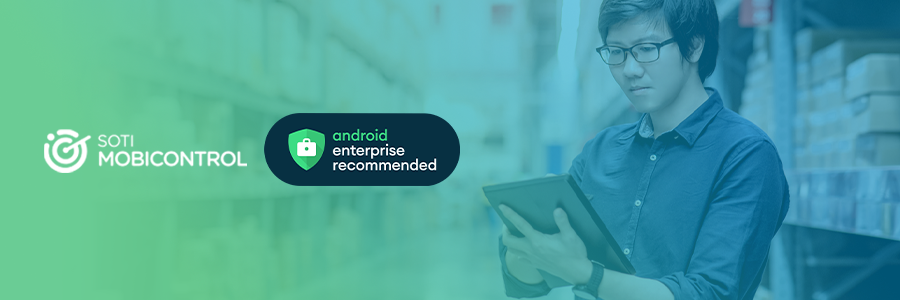
Back in 2010, Google™ released Android 2.2 (Froyo) with the ability to support the management of mobile devices via AndroidTM Device Administrator.
In the decade since, remote work rose by 400%1, along with the overall needs of the enterprise; especially as they relate to mobile device usage. Consider:
-
In 2010, less than 60% of employees brought personal phones and tablets to work.2 Today, nearly 70% of workers utilize Bring Your Own Device (BYOD) in some way.3
-
It took just three years (2011 to 2014) for companies embracing BYOD to grow from 25%4 to 90%.5
-
In 2010, approximately nine billion apps were downloaded worldwide. In 2011, it jumped to 29 billion.6 In 2019, over 200 billion apps were downloaded globally.7
As enterprise mobility became more complex, the Android Device Admin application programming interface (API) was being asked to do more than it could.
The launch of Android 5 (Lollipop) in 2014 introduced Android Enterprise with Fully Managed Device (Device Owner) and Work Profile (Profile Owner) modes. Since then, Device Admin has been considered legacy Android Management.8
Android Enterprise vs. Device Administrator: A Comparison
| Feature | Android Enterprise | Device Admin | Notes |
| Separation of BYOD Data | Available | Not Available | Android Enterprise supports the separation of data in a BYOD scenario. |
| App Distribution and Management | Available | Not Available | Android Enterprise features enhanced app management through Managed Google Play, which was not available in Device Admin. |
| VPN Capabilities | Available | Not Available | Device Admin partially supports VPN whereas Android Enterprise offers full-blown support with its configuration abilities via Managed Configs. |
| Enrollment Features | Available | Not Available | Android Enterprise supports enrollment features such as: zero-touch, Hash Tag, NFC Bump and 2D Barcode. |
| Google Support | Available | Not Available | Supports Android Enterprise deployments as Device Admin is considered legacy management. SOTI supports Device Admin and Android Enterprise deployments. However, Google has announced Device Admin as legacy management with no support to platform-level issues. |
SOTI Recommends Android Enterprise
It is SOTI’s recommendation that you adopt Android Enterprise for modern Android Management.
Now, migrating to Android Enterprise may not be feasible within a mission-critical Android deployment scenario (e.g. devices being used in emergency services or healthcare to facilitate lifesaving aid onsite).
But there is a sensible, logical alternative: “cap-and-grow.”
When new devices come online, they are not managed via Device Admin (cap). Instead, they are managed via Android Enterprise (grow). Now, new and old devices along with Android legacy deployments are concurrently managed until you are ready to move all devices to Android Enterprise.
How SOTI Supports Your Shift to Android Enterprise
-
SOTI is Android Enterprise Recommended: SOTI has earned the Android Enterprise Recommended badge9 by ensuring that SOTI MobiControl – part of the SOTI ONE Platform – is validated against Android Enterprise Recommended requirements.
-
Updates to SOTI MobiControl: SOTI offers world-class Android management and is continuously improving the functionality of our Enterprise Mobility Management (EMM) solution, SOTI MobiControl. While legacy options are still available, Android Enterprise is the default form of Android management for SOTI MobiControl.
-
Training: SOTI has undertaken a comprehensive internal Android training program as part of our Android Enterprise Recommended initiatives. Partnering with SOTI puts you in direct contact with industry-leading Android expertise for EMM.
Do you use Zebra devices?
SOTI was one of the first EMM solution providers to extend Android Enterprise on Zebra devices. Then, SOTI made it even simpler to migrate Zebra devices to Android Enterprise without losing key configuration settings, such as connectivity profiles, custom data rules and alert rules.
Even more impressive? Migration can be done without any end user input or having to send it back to your IT department for a manual factory reset.
Discover how Zebra implemented Android Enterprise migration with SOTI MobiControl and how it benefits your IT staff, your remote workers and your organization.
Five Key Android Enterprise Features on the SOTI ONE Platform
-
Android App Management: The managed Google Play Store is accessible in an iFrame right inside SOTI MobiControl. This allows for the easy and accurate distribution and configuration of public and private apps, all while Google Play Protect continuously scans apps for malicious threats.
-
Android Zero-Touch Enrollment: Zero-touch enrollment enables IT administrators to deploy corporately owned devices at once en masse. For end users, as soon as they turn on the device, all the apps and configurations they need to be productive are installed and ready to go.
-
Powerful Security: Enjoy device-level protection with Verified Boot and critical functions taking place in the Trusted Execution Environment (TEE) along with Android security services such as Google Safe Browsing, Google Play Protect and SafetyNet.
-
OEMConfig: SOTI MobiControl fully supports OEM Config. Android customers can immediately take day zero advantage of new OEM specific management features launched by SOTI partners.
-
Full Support: The SOTI/Google partnership delivers outstanding Android Enterprise support for our shared customers.
Your Version of Android and SOTI MobiControl: What’s Happening
View the table below to locate your version of Android, what to expect as part of its deprecation from Device Admin, and how it impacts your instance of SOTI MobiControl.
| Android Version | Notes | Impact on SOTI Android Management for 2020 and Beyond (Device Admin Only, Android Enterprise Remains Unaffected) |
| Android 8 (Oreo) Released 2017 |
This is the last release where legacy Device Admin is not deprecated. Device Admin devices remaining on Android 8 will not lose any feature support. |
For devices running Android 8 or earlier on Device Admin, there is no change. It is “business as usual.” |
| Android 9 (Pie) Released 2018 |
Key APIs are marked deprecated, but will continue to function. Error logs on Device Admin devices running Android 9 will not impact the end user. |
The end user will not see any impact. |
| Android 10 Released 2019 |
By Q4 of 2020, Google will mandate EMMs update their software in a way where the following APIs will cease working:
|
This release will impact Device Admin management and user experience. In Q4 2020, the following functionality will cease working in non-AE deployments:
|
Other EMM providers will no longer allow enrollment of Device Admin devices on Android 11. However, SOTI is dedicated to maintaining support for our customer’s legacy Android deployments.
Additional Resources
To learn more about SOTI and Android, please check out the following resources:
Contact Us
Reach out to us anytime with your questions about the shift to Android Enterprise, SOTI MobiControl or anything else.
We will get back to you ASAP with the information and answers you need.
Google, Android and Google Play are trademarks of Google LLC.
- TechRepublic, How Remote Work Rose By 400% In the Past Decade
- Fitton, Sandler, and Badgett, Enterprise Mobility for Dummies Special Edition
- TechJury, 41 Stunning BYOD Stats and Facts to Know in 2020
- D Magazine, It’s a Bring Your Own Mobile Device World
- Ingram Micro, 23 BYOD Statistics You Should Be Familiar With
- ABI Research, Android Overtakes Apple with 44% Worldwide Share of Mobile App Downloads
- Statista, Number of Mobile App Downloads Worldwide from 2016 to 2019
- Android Enterprise, Device Admin Depreciation
- Android, Enterprise Solutions Directory



